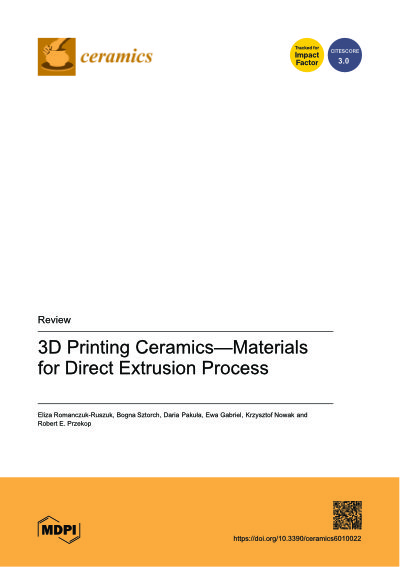Newest Publications

Material extrusion of paste as one of the 3D printing techniques is commonly used in additive manufacturing industry. It allows to efficiently obtain structures of complex geometry at a relatively low cost. Ceramics are among the materials eagerly printed with this technique, especially as a support material. Hence, the combination of silica as base material and nickel as catalyst seems to be a highly promising system in processes such as CO2 methanation or hydrogenation processes.The key aspects that should be taken into consideration when designing a new material are the proper material composition, its microstructure, as well as the final properties. From the point of view of the above-mentioned applications, material should have high open porosity. Appropriate micro- and macroporosity enable the optimal flow of liquid and gaseous reagents through the material, ensuring high efficiency of the processes carried out. It is also crucial to select the appropriate catalytic material, hence the use of nickel as a catalytically active metal was proposed for the research.
This article demonstrates the development, preparation and characterization of silica-nickel porous structures obtained via material extrusion. The nanosilica-Ni paste with 75 wt% of Ni powder particles was prepared with stirring and degassing for homogenous consistency. 3D printed scaffolds have undergone heat treatment to remove the organic binders and partially sintered to achieve a relevant mechanical strength. The analysis of the paste was performed using the detailed thermal analysis, XRD analysis and Raman spectroscopy for a determination of the optimal thermal processing conditions. In addition, the characterization of the final materials was carried out to confirm the effectiveness of the procedures developed. Application of the reductive atmosphere (mixture of N2+H2) during heat treatment prevented nickel particles from oxidation, as well as strongly eliminated the microstructure defects such as cracking and material shrinkage. The results demonstrate the perspective application of material extrusion as a printing technique of highly porous materials with well-preserved pre-designed 3D geometry.

Additive manufacturing and 3D printing methods based on the extrusion of material have become very popular in recent years. There are many methods of printing ceramics, but the direct extrusion method gives the largest range of sizes of printed objects and enables scaling of processes also in large-scale applications. Additionally, the application of this method to ceramic materials is of particular importance due to its low cost, ease of use, and high material utilization. The paper presents the most important literature reports on ceramics printed by direct extrusion. The review includes articles written in English and published between 2017 and 2022. The aim of this literature review was to present the main groups of ceramic materials produced by extrusion-based 3D printing.
